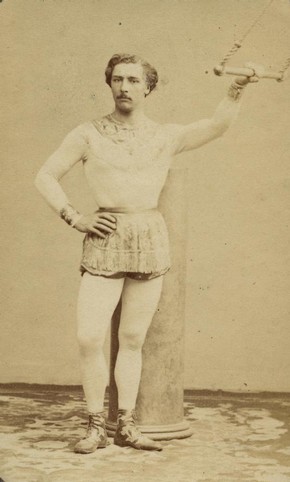The originator of the flying trapeze, Jules Léotard was born in Toulouse, France some time between 1838 and 1842 (accounts vary as do his memoirs). The son of a gymnasium owner and gymnastics teacher, he took to the air almost from birth, some accounts claiming that his parents suspended him from a bar as a baby, finding that it helped to calm the young Jules. Though he initially studied to become a lawyer Léotard's heart eventually led him back to the gymnasium where he began to practice on the trapeze.
His development of the flying trapeze likely stemmed from a feat he began to perform at the gymnasium using the ropes that opened the skylights above the gym's pool. Léotard would swing from rope to rope and later from one trapeze to another. He eventually staged a local performance of his new act and was subsequently hired by the Cirque de l’Imératrice whose director was in the audience during that first performance. It was here that the garment which bears his name was designed at his request after a costumer first outfitted him with a more theatrical costume which he refused to wear.
Léotard never performed with the Cirque de l’Imératrice due to an illness which forced him to cancel his debut. His first public show was instead with the Cirque Napoleon (now the Cirque d'Hiver, the oldest permanent circus in the world) in 1859. The act was an immediate success and spawned a number of imitators as well as a public sensation with his new, form fitting outfit. He went on to take his act to London's Alhambra in 1861 where he performed his 12 minute act over the heads of the audience as they ate dinner below him in the music hall. In 1868 he traveled to America but was waylaid by a fall in Boston that injured his ankle and prevented him from performing for months.
In 1870, Léotard traveled to Spain where he contracted an unknown disease, likely small pox, cholera, or typhoid and died on August 21st of that year. Ironically, he is primarily remembered today not for the act he developed and helped to popularize, but for the garment that was made for him to perform in, a garment which did not bear his name until more than a decade after his death.
